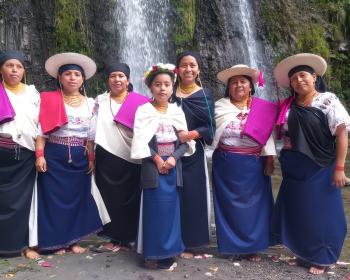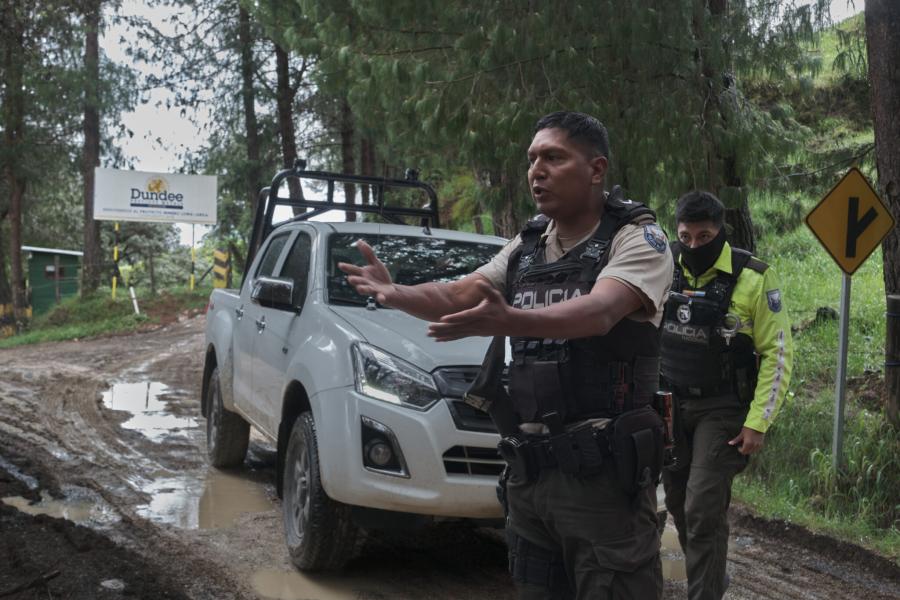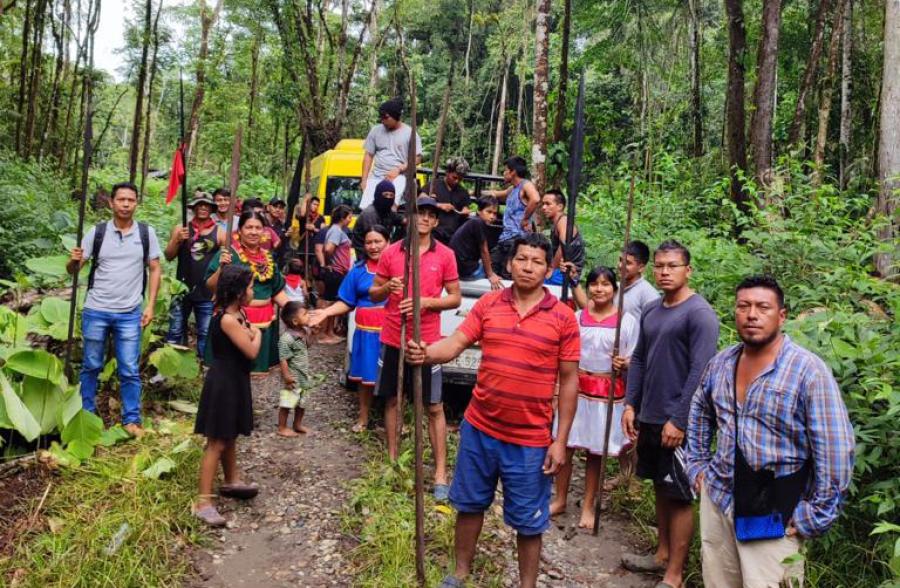The Zápara people live in the Amazon jungle on the border between Peru and Ecuador in the area currently known as Pastaza, bordering on territories of Kichwa, Huaorani, and Achuar peoples. The Zápara were once one of the most important and populous peoples in the area, with 28 ethno-linguistic groups divided into 217 tribes and a population of 98,500 spread across a vast territory. They are now one of the smallest, with no more than 500 people. The neighboring groups, particularly the Kichwa, were converted to Christianity, and there has been great pressure on the Zápara to assimilate, but so far, they have largely resisted.
In the 1940s war between Ecuador and Peru, some of the Zápara community was captured and taken to Peru and could not return until the two countries reopened the borders in 1998. With the opening of the borders the Záparas held a transnational assembly to decide whether to assimilate into Kichwa culture or work on national identity. They decided to unite. Families reunited and began sharing traditional knowledge and revitalizing culture and nationhood, including the Zápara language, which was recognized by UNESCO in 2001 as a “Masterpiece of the Intangible Heritage of Humanity” for its oral traditions and other cultural manifestations.
Meanwhile, oil-companies and other transnationals have been trying to intrude in Zápara territory. While collaborating to stave off this intrusion, today’s Zápara are managing territory according to cultural principles. The Zápara use some 500 plants for food, medicines, woods, craftwork, and decorations. Knowledge of jungle life is detailed, intimate and protocol-laden, and this is reflected in their language. Dreams and the use of ayahuasca (a vine used for spiritual/ceremonial vision) allow shímanos (spiritual leaders) to know how to cure, counsel, predict things to come, and maintain the harmony between the jungle, the spirit world, and humans.
The following interview took place at the United Nations during the 6th Permanent Forum on Indigenous Issues. Gloria Ushigua and her brothers Felipe and Bartolo (respective leaders of the Nacionalidad Zápara del Ecuador and the Federación Binacional de la Nacionalidad Zápara de Ecuador y Perú) were working very hard to have their recommendations heard by the assembly in order to call attention to the threat of encroachment by the oil companies as well as the violent situation with neighboring tribes, exacerbated by the attraction of oil company money. A crucial component of this struggle was that NGO, evangelical, and oil company interests were encouraging other tribes to usurp the Zápara identity in order to gain control of their territory. Amidst all of this, Gloria Ushigua has been working on a medicinal-plant garden with women from several Zápara communities, developing support for traditional medicine, health resources, an exchange system, strengthening of women’s roles and resources, and revitalization of knowledge. She has also been working to win land rights for her people. In spite of the difficulty and cost of getting from her community to cities like Puyo and the danger involved, she is struggling to formalize the title to their territory as a way to protect the Záparas’ land base and culture for future generations. Her efforts threaten the commercial interests in the area, however, and she is increasingly in danger from people who want her land and its resources. She has received many death threats, and in August four men, including one who may have been a police officer, ambushed her and Rosa Gualinga, sprayed tear gas into her face, beat her with clubs and rocks, and stuffed her into the trunk of their car. She was found the next morning lying in the middle of a road, badly injured with broken limbs and the dislocated arm. She is now recovering from that assault.
Kerin Gould: How did you begin your botanical and medicinal plant project and how did you organize?
Gloria Ushigua: We used to know all of these medicines. Then we saw Western medicines, and the community didn’t want to use these herbal medicines. I said, “What’s wrong with you? We don’t have the economy to buy this medicine. Where are we going to get it?” “Oh,” they said, “there is some in the hospital; yes, there they have lots of medicine.” That’s what happens. These days we have to wait a week if someone is sick.
And then I said, “You have to make gardens in each community.” “How are we going to live?” they said. “With our medicine, like before!” I said. “We can find clothes, things like that, and we have food already.”I spent about three months with them and we finished just a while ago. Now the plants are getting really big. Flowers are blooming.
Do the women sell the plants? Or exchange them?
If a person really needs to, they sell them, but among themselves they exchange. They’re united this way. Along the way, the president [of the group] organizes, cleans things up. If somebody’s sick, she knows who knows the most and who should bring that plant to the patient.
So each is an expert in some plants or has a favorite?
Yes, that’s how it is.
I’m thinking about the division of Záparas across the Ecuador and Peru border. Does this project help unify your people’s knowledge?
Some have the history and knowledge in Peru. The shamanism, they have it in Peru, and Ecuador has none. Ecuador has the language, stories, and everything. It’s an exchange to learn all this. That was my idea.
When you envisioned the project, what were your goals?
Those of us who are the carry-overs of shamanism and are learning, we can’t do anything else, because the plants had to be used by only us. Only I can say, “This is what you are going to use. I can do this for you, for anybody who is sick.” And that wasn’t good, I felt, because I don’t live there with them.
So I said, “Each of you has to learn, but you aren’t shímanos, just people who know [the plants]. I can teach you.” My vision wasn’t about making pills and all that, just using plants as is. Like in my father’s time, we had an ayahuasca vine, really big, really thick. I don’t know where it came from or what year it appeared. It was immense and very ugly. I took it twice, and I was looking at the whole world.
For some projects like this, the very secret part we keep to ourselves. We only talk about it with the Big Teacher and the two younger ones [the Big Teacher is her uncle, the shímano who is teaching her and another student]. One place we have, Supayurco, is inside the mountain. When you die you have to live under this mountain, and that lagoon is very green. Before, when I was little, I didn’t know what my father was talking about when he mentioned this. But when I learned it, when I saw, it was different. I went in, and it was a beautiful thing. There were hundreds of different types of animals. And inside of this were my father and my grandfather. There were other people there, and I spoke with them. The Big Teacher asked me: “How are you seeing it? Is this thing true or is it not true? Are you only imagining or are you seeing directly?”
There are three of us: two young ones and the elder who is above us. They asked a young man this same question, but I don’t think he was at that point, as he began to say things that weren’t real. We have to say what we really see. I tell it the way I see it because I am seeing it. And this secret, one has to keep. The Professor says we have to keep it inside.
So that’s how you make decisions about what plans to make, through ayahuasca?
We also see who is going to die there. It’s real; that’s how we see. We sit, we look with our own eyes. The thing that we see, that’s what’s going to happen.
I want to do this with the kids. I want to teach them my way of seeing, not the outsiders’. I want to teach that. They have to learn and share it with the other kids. If I die, I disappear with my way of seeing. Even if they attack you with weapons, you have to leave something behind.
In your situation it seems a little dangerous to even talk openly about your values, right?
Very dangerous, yes. When enemies come looking for me my friend says, “hide.” I have to lock myself in, and she says, “She’s not here. I don’t know where she is.” It’s embarrassing, but people come like that. They look and look and then tell someone to come with weapons and kill me. The police don’t say anything. That’s how it is—a little dangerous for me. It’s very delicate.
How does this garden project represent the values, the thinking, philosophy of Zápara? Your big traditions?
I wanted to achieve all that the shímanos did. I said to my father, “I’m going to learn to take ayahuasca and see. You have to advise me about all that.” My dad didn’t accept my idea. He said, “You are a woman. They’ll surely kill you right away.” I said, “I don’t care if they kill me. I want to learn.” I pestered him and pestered him. So my mom said, “Accept it. She wants to do be that.” He accepted, and we both took ayahuasca. Then he told me, “This stays here. You’re not going to toss it out and say you learned this today. Friends will be there for you but not the way you think. These are friends with a different kind of life.” I said that it would be my secret. I was seeing that the plant had its person.
How did the participants in this project get together?
It was interesting to them to talk about the things that were, according to them, lost. But they were inside of me, since I went to Peru a lot to learn my father’s thing. One woman spoke up and said, “Why can’t we make medicines? Why don’t you contact a doctor?” I said that if we contact a doctor he would carry off all our plants and we’ll be left empty. They said, “You could send some of the boys, perhaps three boys, to be trained at a doctor’s about how to make medicines. This would be to sell and have some money for ourselves as well, because our lives our changing and it’s going to be different.”
Do you use money more than before?
Yes, because now they attack us, and without money how are we going to pay lawyers? They are crushing us with money, and without money how can we [defend ourselves]? That’s what the lady said. And I said, well, that’s a good idea, but those are very strong words. We can find another way so that we save some of this plant to take care of our territory. They said, “We will have problems with the oil companies and when they come in and we want to kick them out, with what papers are we going to stop them, with what money?”
In all of this, do you talk about traditional stories, your history or origin stories?
Yes. I tell them about Piatsaw—how our god came, how he appeared, where food comes from, all that. I’ll tell you my story of Piatsaw: Piatsaw lived alone. He didn’t have anybody to keep him company. He was thinking, “Who am I going to talk with?” So he went to the jungle and spoke with a palm. It was a chambira [a palm], which has lots of thorns. When he struck this chambira a boy came out and said, “Where am I?” And Piatsaw took him home. The boy didn’t even know what food was. The boy began to bother Piatsaw. “Piatsaw, let’s play! Let’s play!” Pitsaw said, “I don’t want to play. Let’s go make the garden.” And they made a really little garden. Then Piatsaw said, “Let’s go back home,” but the boy stayed. He took sticks and went pam-pam-pam. And when the boy came back again something like people came out, but different from people. I think they came out as bones and started to walk around all bent. The boy went running to find Piatsaw to tell him. Piatsaw said, “No! You shouldn’t do that - I have to do that, not you.”
The boy said, “I need a mother.” Then Piatsaw said, “Let’s go to the jungle, near some very big trees.” Standing there, the boy said, “Come out, woman, come out”’ so a woman came out for them. That woman was little—not good. They took her home. They spent two days at home and she grew there. Piatsaw took 10 pubic hairs from her and wrapped them in a leaf. He said, ‘Let’s go somewhere else.’ That was Piatsaw’s idea for making other people: from those little hairs came people. He carried them, but he left them with the boy when he went to urinate on the way. The boy, who was a little bit of a brat, took out those hairs and they took off running. They turned into animals, those hairs. Piatsaw got mad and spanked him, and he kicked the boy out.
Then he went on and reached a little hill. He started to clear it. The boy looked from where he was hiding. “What is he doing with those hairs?” he asked himself. Piatsaw planted each hair, sowing them under the trees, and people came up, different people with families. The boy was scared. Piatsaw went home, and [a little later] the boy came back to tell, “People came up!” Right there Piatsaw got mad and said, “Now you are going to fly up to the sky in case they die!” Pshhht, the boy was carried off and disappeared. That’s it.
So, then, plants and people…
We are the same. That’s why we love the plants so much. If you cut them they bleed. They will cry.
This article is adapted from Kerin Gould’s doctoral dissertation at the University of California, Davis.



